 amuel Edmund Oppenheim (1901-1992) occupies a
unique place in the history of American painting.
A thoroughgoing Impressionist, he was a student
of Charles Hawthorne on Cape Cod and Harvey Dunn
in New York. Another strong influence was Walter
Biggs, the incomparable American illustrator whose
freely-brushed watercolor paintings graced most
leading magazines in the early decades of the
Twentieth Century. Oppenheim was principally a
painter of charming easel pictures which exude
a gracious, mellow poetry. Several motifs recur
with frequency in his oeuvre: mother and child
in an idyllic landscape, beautiful women posing
modestly in a gentle Victorian interior, lush
floral still lifes, young ballerinas posing in
stage costume, decorous nudes in a domestic interior.
amuel Edmund Oppenheim (1901-1992) occupies a
unique place in the history of American painting.
A thoroughgoing Impressionist, he was a student
of Charles Hawthorne on Cape Cod and Harvey Dunn
in New York. Another strong influence was Walter
Biggs, the incomparable American illustrator whose
freely-brushed watercolor paintings graced most
leading magazines in the early decades of the
Twentieth Century. Oppenheim was principally a
painter of charming easel pictures which exude
a gracious, mellow poetry. Several motifs recur
with frequency in his oeuvre: mother and child
in an idyllic landscape, beautiful women posing
modestly in a gentle Victorian interior, lush
floral still lifes, young ballerinas posing in
stage costume, decorous nudes in a domestic interior.
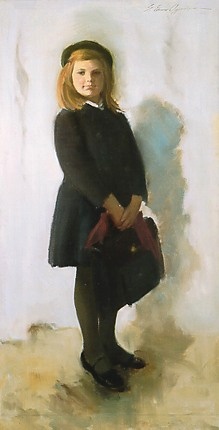
Portrait
of Tammy, 1962.
Oil on canvas, 59 x 30 inches.
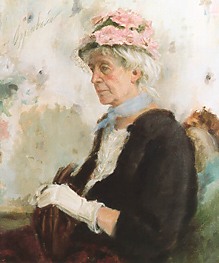
Lady in a Pink Hat, 1970.
Oil on canvas, 30 x 25 inches.
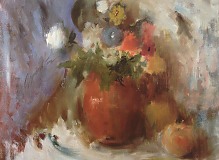
The Blue Curtain, 1966.
Oil on canvas, 22 x 30 inches.
|
 |
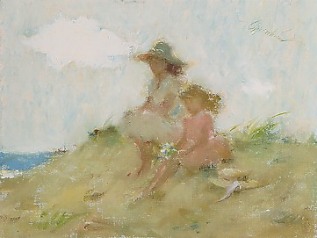
The Hilltop,
1979.
Oil on canvas, 9 x 12 inches.
But Oppenheim also painted many portraits professionally,
strong in characterization and rich in painterly
qualities. These masterly portraits, hanging
in public and private collections throughout
the United States, firmly establish his right
to be considered among the foremost American
portraitists. It was his popular portrait classes
at the Art Students League in New York, featuring
his electrifying demonstrations, that created
his enduring reputation as a teacher.
I myself was a student in those League classes,
and I credit Oppenheim with awakening my awareness
of what painting is all about. From the very
beginning, I set out to emulate the Oppenheim
technique. The soft edges, the flowing brush
strokes, the selective focus, the mystery and
elegance of the conception, all this was fascinating.
But behind it all was a solid, honest realism
standing firmly on the bedrock of observation.
"Observation is everything," he would
say. "Look and see what is there. The model
is the teacher in this class. She says nothing,
but she tells you everything."
Essential to the technique were two concepts:
first, drawing is the key to painting. Behind
everything is accuracy of observation in drawing
and, second, the tonal values must be right.
It must be right in black and white before it
can be right in color. Exquisite color will
not save a painting that is faulty in drawing
and inaccurate in value.
He was committed to the concept of the single-sitting
portrait study as the basic discipline. He felt
that the urgency of the time constraint forced
the artist to concentrate on essentials.
We worked on a white canvas, mixing on a white
palette. We made no preliminary drawing in another
medium, but rather proceeded directly with the
brush, blocking in the architecture of the head
as simply but accurately as possible. Ten percent
of the total working time was to be devoted
to this drawing.
Then we proceeded to lay in our main tones,
working with the largest brush possible, stating
the darks first, then the halftones, finally
the lights. And always the values—the
values! The values must be right! As he made
his way among the forest of easels in the class,
the commentary was succinct and direct, and
invariably involved the values. "The eyes
are too dark!" or "The highlight on
the forehead is much too light!" "Look
over there and see what is there!"
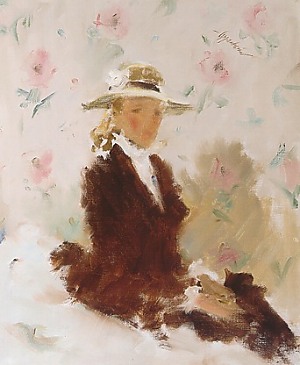
Woman
with Flowered Background, 1988.
Oil on canvas, 30 x 24 inches.
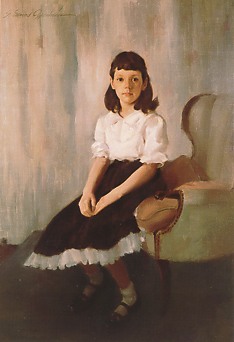
The
Age of Innocence, 1950.
Oil on canvas, 57 x 40 inches. |
Samuel Edmund Oppenheim left an enduring legacy
of student/disciples, and a body of joyous Impressionist
paintings that continue to delight and instruct.
|